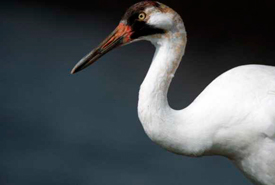
Whooping crane (Photo from U.S. Fish and Wildlife Services/Flickr)
Whooping crane
A stark silhouette set against the prairie horizon, whooping cranes claim the title of the tallest bird in North America. This bird species has made a comeback since the 1940s, when there were only 21 individuals remaining. In 2017, a record number of 98 nests were recorded in Wood Buffalo National Park. By 2018, there were more than 800 whooping cranes in the wild and in captivity. Recovery efforts included captive breeding programs and a reintroduction to the wild, with a migratory Wisconsin-Florida population having been taught to migrate using ultralight aircrafts. These birds are long-lived; it is estimated that they can live up to 30 years or more in the wild. One captive bird used for breeding lived to be 39.
What does the whooping crane look like?
Whooping cranes are birds of large stature — their long neck, slender body and long legs put them at about 1.5 metres tall, and, in flight, their wingspan can measure more than 2 metres. Adult birds have red, black and grey feathers marking their head, which are in high contrast to the white on their body. Immature whooping cranes are whitish and mottled with brownish feathers. Their legs, wingtips and bills are black.
Where does the whooping crane live?
The only self-sustaining wild population of whooping cranes breeds in Canada’s Wood Buffalo National Park, which straddles the Northwest Territories and Alberta border, and winters primarily in the Aransas National Wildlife Refuge in Texas. During migration season they can be seen on various Nature Conservancy of Canada (NCC) properties in the Upper Qu’Appelle, West Parklands and West Boreal Transition natural areas in Saskatchewan.
During their summer breeding season, whooping cranes inhabit areas with poorly drained soil, with wetlands or shallow ponds separated by narrow ridges where trees such as white and black spruce and tamarack grow. Large nests are usually built in shallow water. The male and female build the nest by making a pile of vegetation and then compacting it.
In their Texan wintering ground, the birds can be found in tidal flats, shallow bays and estuarine marshes along the coast.
What does the whooping crane eat?
Whooping cranes are omnivorous, eating a variety of animals and plants. On their breeding grounds in Canada, they primarily eat snails, crustaceans, aquatic insects, minnows, frogs and snakes. During migration, birds sometimes feed on waste grains from fields, such as barley, wheat and corn. Along the Gulf Coast, whooping cranes take advantage of the local specialties, primarily feeding on crabs and clams.
What is the whooping crane's conservation status?
Whooping cranes are assessed as endangered by the Committee on the Status of Endangered Wildlife in Canada and are protected under the Species at Risk Act. Historical evidence suggests that this crane was more widespread, but never common, in the past, with an estimated population of more than 10,000 individuals prior to European settlement. With the arrival of settlers in the 1800s, which brought about agriculture and hunting, whooping cranes started to disappear.
Primary threats to the birds during migration include power line collisions and hunting as a result of being mistaken for game birds. Their wintering ground in Aransas National Wildlife Refuge is also prone to severe weather events and contaminant spills, putting the birds’ safety at risk. Because a large proportion of the global population is concentrated into a relatively small area, threats arising on the wintering grounds are more likely to have a severe effect on the population.
What is NCC doing to help protect the whooping crane's habitat?
NCC is conserving areas along the whooping crane’s migratory route through Saskatchewan, specifically in the West Boreal Transition, West Parklands and Upper Qu’Appelle natural areas.





